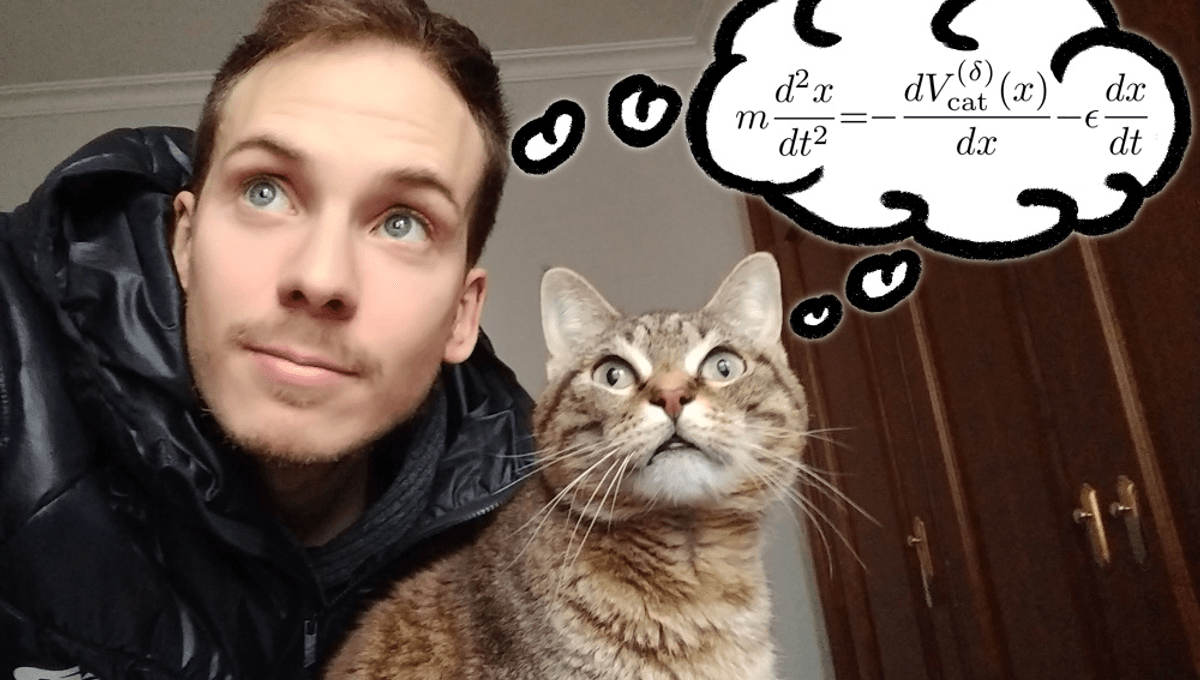
Physicist Dr Anxo Biasi of the Instituto Galego de Física de Altas Enerxías believes he has found something almost as elusive to his discipline as grand unified field theory: the equation of cat motion. Like a kitten faced with an insufficient restraining wall, Biasi has even leapt over the most basic case of feline behavior in isolation to tackle the two-body problem of how cats behave in the presence of a human.
Despite his recent disgrace, Erwin Schrödinger made two major contributions to physics, the wave equation and the notion of a cat in quantum superposition. Felis catus have been linked to advanced physics ever since (although some would argue the connection dates back to fascination with the way cats rewrite physics as they fall).
It seemed this connection might have reached its epitome with the awarding of an Ig Nobel Prize for showing cats can be both liquid and solid. However, Biasi thinks there is yet more to do on the topic. “This article aims to bring physics closer to non-experts, offering a pleasant example through which it is possible to understand several concepts of classical mechanics,” Biasi writes in a statement. “To do so, an equation is constructed that models the behavior of a cat in the presence of a person, considering the former as a point particle that moves in a potential induced by the human.”
Although assistance was sought from friends familiar with the ways of cats, the work is primarily based on observations of a single cat, Eme, who shares Biasi’s home. Biasi began with the hypothesis, “Cats behave as if they perceive a force around a person,” and then identified seven patterns in Eme’s motions, which he modeled.
Presumptuously, Biasi places the human at the center of the modeling by defining their location as x=0 when the cat’s position as x. If m is the cat’s mass, and ϵ the coefficient of friction created by the cat’s fatigue, Biasi begins with a basic formula of md2x/dt2 = – dV(δ)cat(x)/dx – ϵdx/dt.
From there, Biasi uses his observation of Eme’s patterns to add complicating factors to his model, such purring and the nighttime rushes known as the zoomies.
Biasi said, “This started as a playful idea for Fool’s Day […] However, I soon realized that this story I created could be of great help to physics students.”
Cat purring presents an opportunity to demonstrate the physics of a self-reinforcing system, for example, with Biasi arguing, “It is proposed that when a cat is being stroked and starts to purr, people tend to feel the impulse to continue stroking it, thus reinforcing the stability of the process.” Who knows how many have been delayed from important duties – perhaps even major physics breakthroughs – by the force of a purring cat on a lap, immovable morally if not physically?
Biasi considers lap-sitting and five other behavior patterns – including failure to respond to calls, distractibility, and oscillation on patting – to all fall under the low-energy limit. However, the zoomies (also known as frenetic random activity periods, or FRAP) involve a higher energy state. FRAP can only be modeled by introducing a randomization function because, let’s face it, not even the cat knows where it is going to go next. Biasi adds an additional term, σf(t), to reflect this, treating a zoomying cat’s movements as a stochastic process using the Euler–Maruyama method used to model Brownian motion.
IFLScience of course respects peer review on this, as other papers, but since Biasi is describing the work as more about science communication than physics, we consider ourselves to be his peers, and have some concerns.
For one thing, Biasi is listed as sole author on the paper. If F.D.C Willard can get co-authorship on a physics paper for providing nothing but pluralization, we consider this serious Eme erasure. Even the acknowledgements read, “The author is grateful to his cat for being his source of inspiration.” Failure to mention Eme by name seems an unfortunate hark-back to days when authors would thank their wives for labor without mentioning them by name.
More significantly, Biasi notes that his modeling is entirely classical mechanics, with the cat treated as “a point particle obeying Newton’s mechanics”. Given cats established quantum behavior this seems a grave oversimplification, even in the unlikely event a cat would obey anyone’s laws, Newton included.
To be fair, Biasi acknowledges his equations “are not universal and some cats may display a weaker version of some of them.” Biasi also claims that his work can “reproduce characteristic [cat] behaviors”, so those capable of understanding his equations, and with a cat to observe, can assess the accuracy themselves.
The study is published open access in the American Journal of Physics.
Source Link: A Physicist Thinks He’s Found The Equation For How Cats Move